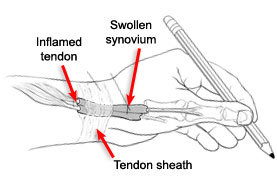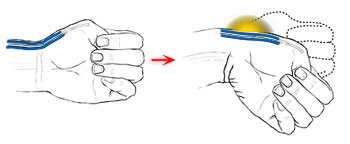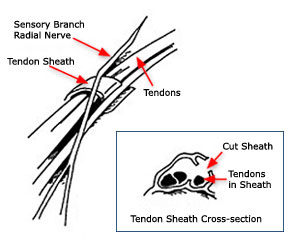
De Quervain's Tendinosis
De Quervain's tendinosis occurs when the tendons around the base of the thumb are irritated or constricted. The word "tendinosis" refers to a swelling of the tendons. Swelling of the tendons, and the tendon sheath, can cause pain and tenderness along the thumb side of the wrist. This is particularly noticeable when forming a fist, grasping or gripping something, or when turning the wrist.
AnatomyTwo of the main tendons to the thumb pass through a tunnel (or series of pulleys) located on the thumb side of the wrist. Tendons are rope-like structures that attach muscle to bone. Tendons are covered by a slippery thin soft-tissue layer, called synovium. This layer allows the tendons to slide easily through a fibrous tunnel called a sheath.
Any swelling of the tendons and/or thickening of the sheath, results in increased friction and pain with certain thumb and wrist movements.
 De Quervain tenosynovitis of the first extensor compartment.
Reproduced with permission from: Griffin LY (ed): Essentials of Musculoskeletal Care, 3rd Edition. Rosemont, IL. American Academy of Orthopaedic Surgeons, 2005.
Causes
De Quervain tenosynovitis of the first extensor compartment.
Reproduced with permission from: Griffin LY (ed): Essentials of Musculoskeletal Care, 3rd Edition. Rosemont, IL. American Academy of Orthopaedic Surgeons, 2005.
Causes
De Quervain's tendinosis may be caused by overuse. It also is associated with pregnancy and rheumatoid disease. It is most common in middle-aged women.
SymptomsSigns of De Quervain's tendinosis:
- Pain may be felt over the thumb side of the wrist. This is the main symptom. The pain may appear either gradually or suddenly. Pain is felt in the wrist and can travel up the forearm. The pain is usually worse when the hand and thumb are in use. This is especially true when forcefully grasping objects or twisting the wrist.
- Swelling may be seen over the thumb side of the wrist. This swelling may accompany a fluid-filled cyst in this region.
- A "catching" or "snapping" sensation may be felt when moving the thumb.
- Pain and swelling may make it difficult to move the thumb and wrist.
To determine whether or not you have De Quervain's tendinosis, your physician may ask you to perform the Finkelstein test by placing your thumb against your hand, making a fist with your fingers closed over your thumb, and then bending your wrist toward your little finger.
 Finkelstein test. Arrow indicates location of pain when test is positive.
Adapted with permission from the American Society for Surgery of the Hand: Brochure: de Quervain's Stenosing Tenosynovitis. Engelwood, CO, 1995.
If you have De Quervain's tendinosis, this test is quite painful, causing tendon pain on the thumb side of the wrist.
Treatment
Finkelstein test. Arrow indicates location of pain when test is positive.
Adapted with permission from the American Society for Surgery of the Hand: Brochure: de Quervain's Stenosing Tenosynovitis. Engelwood, CO, 1995.
If you have De Quervain's tendinosis, this test is quite painful, causing tendon pain on the thumb side of the wrist.
Treatment
The goal in treating de Quervain's tendinosis is to relieve the pain caused by irritation and swelling.
Nonsurgical Treatment
- Splints. Splints may be used to rest the thumb and wrist.
- Anti-inflammatory medication (NSAIDs). These medications can be taken by mouth or injected into a tendon compartment. This may help reduce swelling and relieve pain.
- Avoiding activities that cause pain and swelling. This may allow the symptoms to go away on their own.
- Corticosteroids. Injection of corticosteroids into the tendon sheath may help reduce swelling and pain.
Surgical Treatment
Surgery may be recommended if symptoms are severe or do not improve. The goal of surgery is to open the thumb compartment (covering) to make more room for the irritated tendons.
 Surgery opens the sheath over the inflamed tendons.
Regardless of the treatment, normal use of the hand usually can be resumed once comfort and strength have returned. Your orthopaedic surgeon can advise you on the best treatment for your situation.
Surgery opens the sheath over the inflamed tendons.
Regardless of the treatment, normal use of the hand usually can be resumed once comfort and strength have returned. Your orthopaedic surgeon can advise you on the best treatment for your situation.
If you found this article helpful, you may also be interested in Flexor Tendon Injuries.
Source: http://orthoinfo.aaos.org/topic.cfm?topic=A00007
